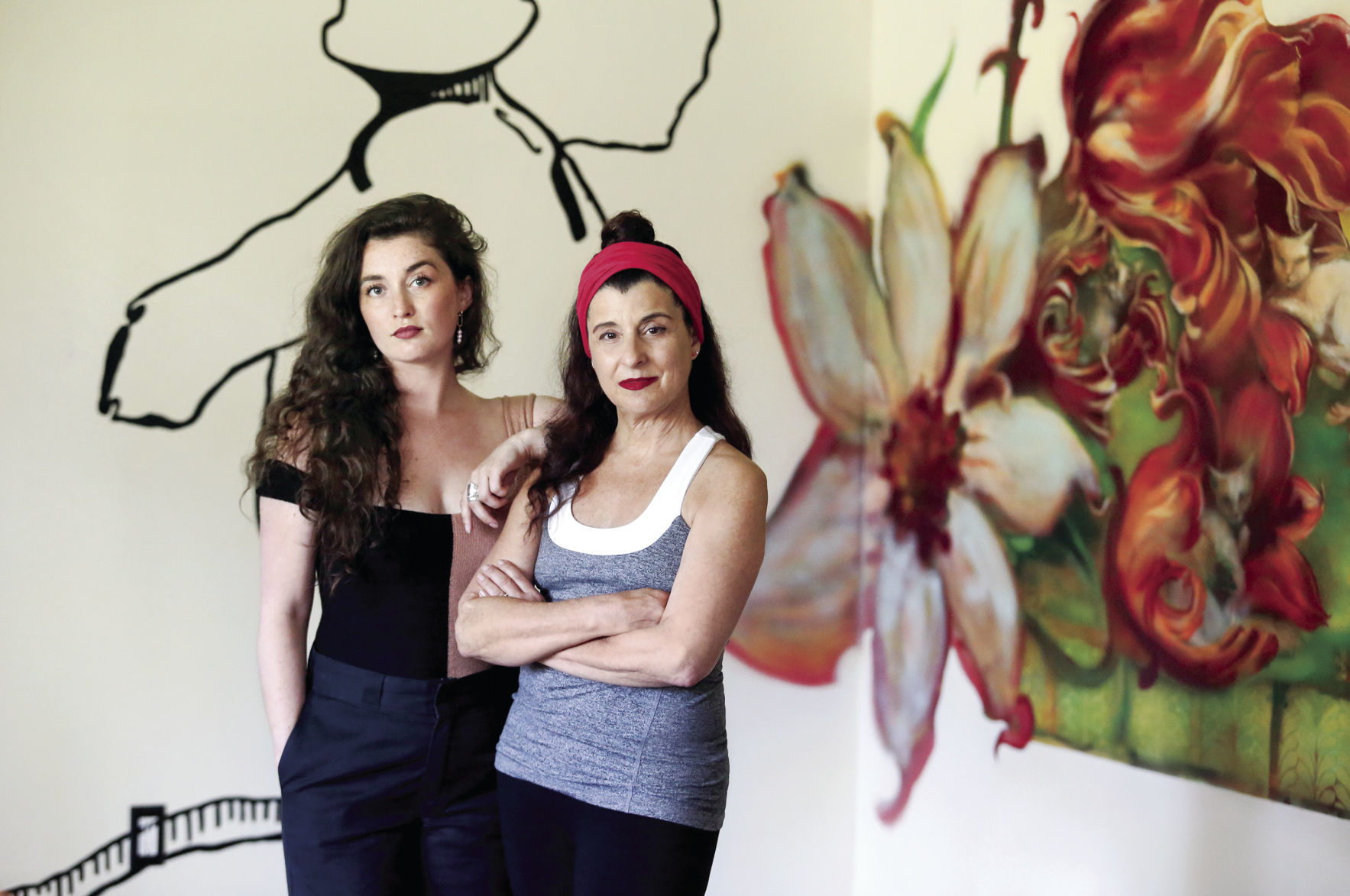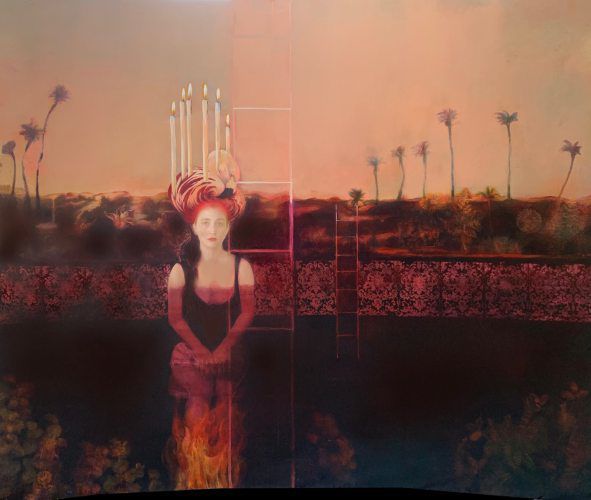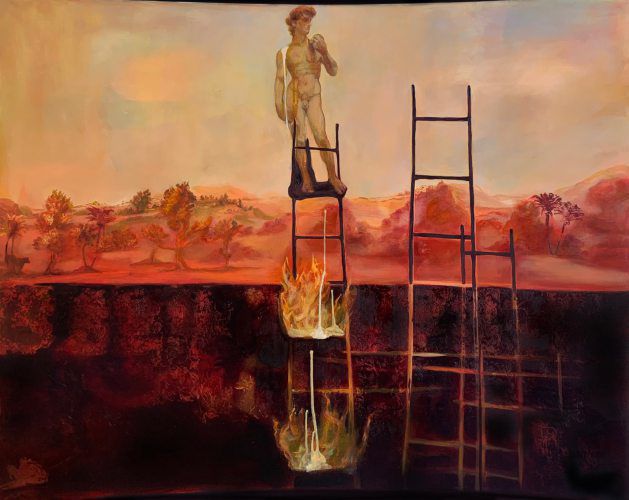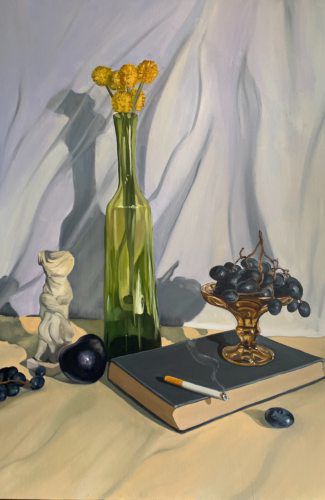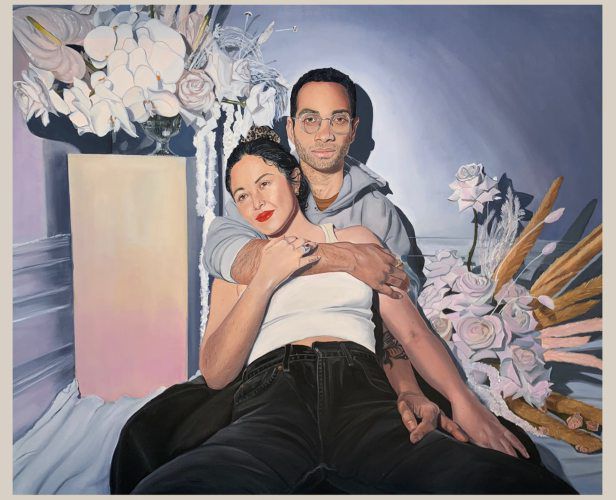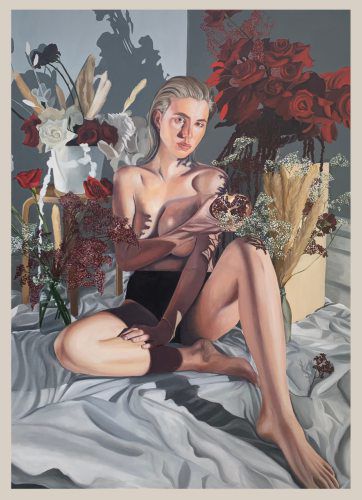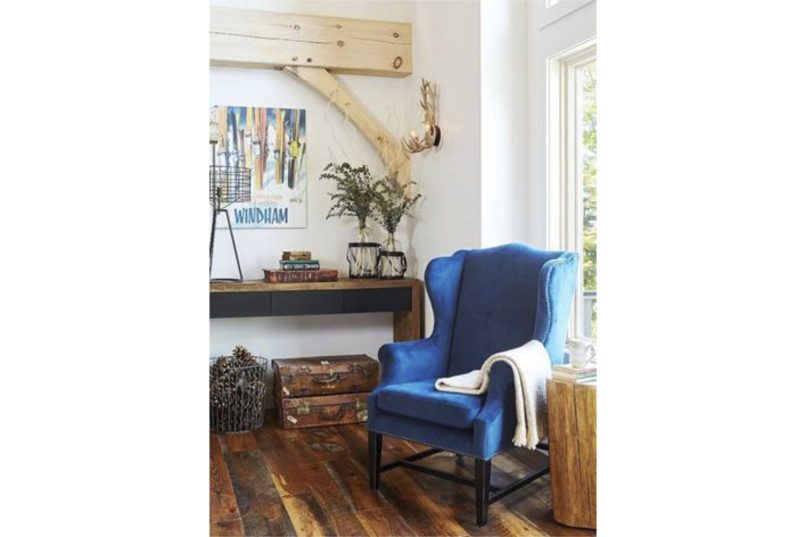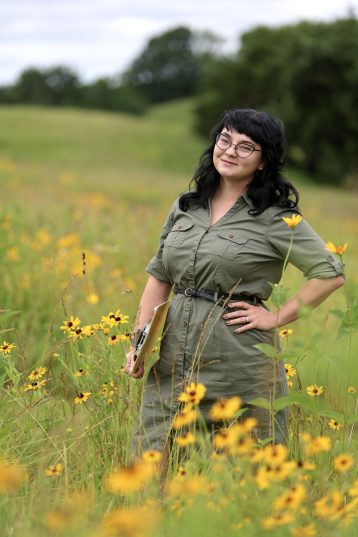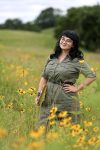It’s an overcast and breezy afternoon. A lingering chill hangs in the spring air.
It’s not a day particularly conducive to painting a large-scale mural on the exterior of a building. But painters Wendy S. Rolfe and Thérèse Mulgrew are making the best of it, adding the finishing touches to a vintage-inspired Dubuque postcard that now graces a wall located in the alley between White and Jackson streets, near East 10th Street.
“This one has been really challenging,” said Thérèse, looking up at the work completed so far.
It’s the second mural she has had a hand in creating as part of the Voices Productions project spearheaded by her father, Sam Mulgrew, in which a series of colorful murals have taken shape on buildings throughout Dubuque.
The first, “T.J.M. Still Life,” is located at 30 Main St. and was painted last year in tribute to her familial roots.
This latest mural also contains ties to family. The inspiration for it came through Thérèse’s father, but it was designed by Wendy, her mother.
“We’re painters, but painting a mural is different,” Thérèse explained. “There are people who specialize specifically in painting murals. We approach it as studio painters. There are different techniques.”
“It’s hard, too, because it’s like our gift to the city,” Wendy chimed in. “So, I think we’re feeling that pressure.”
But the larger-than-life murals are just the tip of the iceberg when it comes to the creative prowess that runs deep in mother and daughter.
Wendy, 61, has made painting her creative focal point for the past 40-plus years, with a vast body of work. And while Thérèse might appear as the inevitable “apple that didn’t fall far from the tree,” the 29-year-old began painting only a year ago.
In that time, she’s made swift strides, completing her first series of paintings that also netted her an exhibition dubbed, “Unfolding,” earlier in the year at New York City’s Freight + Volume. A prior exhibition also took place at Femme Fatale in Brooklyn.
Growing up in Dubuque, Thérèse has called Chicago home since last fall, when she moved back to the Midwest to pursue art after working in New York City’s bustling fashion industry for six years.
“New York is just too expensive,” she said. “I could never be a full-time artist in New York the way I can be in Chicago.”
Wendy has continued to call Dubuque home, not only dedicating time toward her studio practice but also working with husband Sam to expand art’s reach throughout the city.
Although the women have painting in common, their work and approach to it couldn’t be more different.
“She’s teaching me how to just put things down and not to overthink the details,” Wendy said of her daughter, whom she affectionately refers to as Tess. “I’ll do that, and then it takes me much longer to get a painting finished.”
“And she’s teaching me how to take my time,” Thérèse said. “I just like to do it and get it out there.”
“We are really in a type of exchange, even though we’re both opposites in our painting,” Wendy added. “I’ve been painting longer, but something’s going on with Tess. She’s painted too quickly, whereas I have seen people sloppily and in a very clumsy way go along, but it takes awhile before they get their rhythm. Tess got it right away. It’s almost like her talent is ahead of her.”
Art in their blood
Creativity has long abounded in the family.
“On both sides of the family, we have artists and writers,” Wendy said. “We’re filled to the brim. It’s sort of our lineage.”
Matriarch Joan Mulgrew, who passed away in 2006 at age 78, was a painter beloved as much for her artistic talents as she was for her contributions to the local art community. She studied under the tutelage of renown Dubuque-based artist Frank Licciardi and had her work displayed throughout the United States and Europe.
Joan attended Sacred Heart Boarding School for Girls in Pennsylvania, where she met lifelong friend Jean Kennedy — the sister of John F. and Robert Kennedy. After serving as an asistant to John F. Kennedy’s during his bid for Congress, Joan relocated to Chicago, where she found work as an art director for an advertising agency. She also met Thomas James Mulgrew II, and after marrying in 1952, the couple made a home in Dubuque, where they had eight children.
One of those was Kate Mulgrew, who went on to a successful acting career, appearing as Captain Kathryn Janeway on “Star Trek: Voyager” and Galina “Red” Reznikov on “Orange is the New Black.” Kate’s son, Alec Egan, took after his grandmother, also embarking upon a career as a painter. Meanwhile, Kate’s brother, Sam was called toward a role in the business of the arts.
Worlds collide
Sam attended Wahlert Catholic High School and Loras College before embarking upon studies in intellectual history in New York City. It was there that he met an aspiring artist — Wendy.
“I grew up in Marblehead, Mass., outside of Boston,” said Wendy, who also has a brother who is a painter. “When I was younger, I had a lot of craziness and left home at 17. Somebody turned me on to taking a life-drawing class in town — not in a school, though, because I was a derelict, and nobody would let me in the art department. So, I ended up just painting with this guy. He didn’t say much to me, but one day, he came up and was like, ‘I want you to keep coming, and I don’t want you paying anything.’”
She did, learning to paint portraits and more.
“Similar to my daughter, it was something that balanced me,” Wendy said. “It got me to a place where I could lose myself and lose my world so I didn’t have to think so much. I just started to follow the breadcrumbs from there.”
After that, Wendy attended the University of Tampa (Fla.) before relocating to San Francisco for studio school and work, also in the fashion industry. She also spent a year in Paris, ultimately landing in New York City, where her brother lived, where she met her husband and where she attended Parsons School of Design.
“After that, I was working very hard and went through a period of about four years where I wasn’t inspired and wasn’t painting at all,” Wendy said. “I went back to school and studied graphic design. It gave me tools I had never had before, so it empowered me, and I loved it.”
Wendy and Sam wed and returned to Dubuque, where Sam served on boards and committees for various arts agencies and museums. The creative energy in Dubuque helped fuel Wendy’s desire to begin painting again, particularly through Voices from the Warehouse and Voices Productions.
While the couple, married 30 years, had two daughters, they never encouraged either to paint.
“Tess never came into my studio when she was younger, and she never talked to me about paining,” Wendy said. “It’s a hard life, and I always thought, ‘No. Try to do something else.’ However, her painting has been a happy surprise and a phenomenon.”
Thérèse, too, admitted she steered clear of painting at first.
“I think because I had all of these painters in my family, I kind of avoided it,” she said. “I knew I wanted to be an artist or be in the arts, but I think I wanted to carve my own path.”
Thérèse studied English at the University of Iowa and moved to New York City with the ambition to produce live music events before falling into the fashion industry as a style assistant for photo shoots with Art + Commerce, Milk Studios, Marc Jacobs and others. She found solace in writing and drawing.
“I was surrounded by a cool, creative and inspiring work environment in the fashion industry, but the work I was doing wasn’t actually that creative at all,” she said. “At one point, I got promoted. I was in an office all day, and I was so depressed. I also was my aunt Kate’s assistant for awhile. I just felt like it was always me assisting other artists. I did’t want to be a part of something creative and not be doing the creative thing. I wanted to be the artist in my own life.”
Thérèse decided on a whim to take a painting class offered by her drawing instructor.
“I kind of wanted to master drawing first, but he said, ‘No. They’re totally different mediums, which I learned very quickly,” she said. “I felt like I spent my whole life drawing, and I was not very good. Then, I started painting, and it immediately felt right and came naturally. I loved it and knew I needed to change everything because I wanted to do it full time.”
Wendy referred to Thérèse’s natural ability as a “perfect storm.”
“Her understanding of photography, lighting, styling — all of these talents she had been playing around with for all these years came together in her painting,” she said. “I told her to be patient with herself because it takes a very long time to learn to paint. But by the third painting she sent me, it was intriguing.”
The two agreed that when it comes to art, no one pursues it because they want “a successful, happy, cozy life.”
“I think for both of us, it was out of necessity,” Thérèse said. “We do this because we can’t not do this. We’ve talked a lot about school and technique and learning. I think in a lot of art, there is this place where you don’t really know what you’re making or how you made it. (Wendy) studied under incredible people for a long time, and she got to this incredible place. She’s a masterful painter compared to me. But I feel like part of what I have going for me is that I don’t really know what I’m doing.”
Bodies of work
Wendy described her work as spiritual and psychological in nature.
“My work is symbolic — a little bit surreal,” she said. “It’s full of psychology. I studied dreams for a long time, so I have a lot of that going on. I was a born-again Christian. Then, I was Catholic, which I am still in my own way. I’ve always been interested in the wisdom of traditions and my growth out of sheer survival. My stability was going into religion a little bit. And that certainly became a part of my work but in a playful way. I’ve grown with that. My work is all about understanding enlightenment as far as being responsible for our motives in life — less judgement and being self-aware.”
Thérèse’s emphasis explores photographing and painting the people she loves.
“My relationships are really important to me, so I want my painting to feel like an extension of that and my history with these people,” she said.
Support also runs as rampant in the family as creativity.
“There is a value for art,” Wendy said. “When someone like Tess decides they want to pursue it, everyone in the family gathers around that person saying, ‘How can we make this work for you?’ It’s incredible. So, we’re lucky.”
Megan Gloss writes for the Telegraph Herald.

